The Beauty of Bengali Temples - Part 1
BY: SUN STAFF
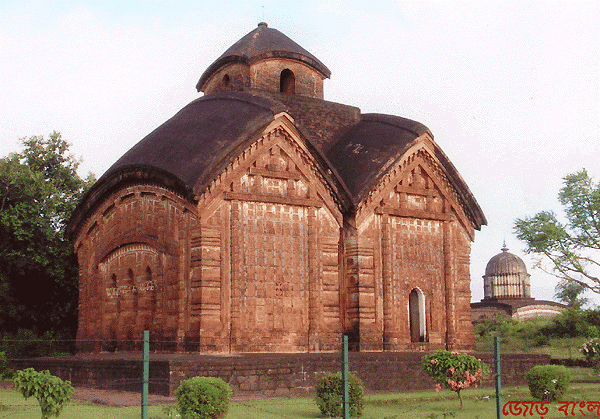
Jor-bangala Temple
Sep 28, CANADA (SUN) — When considering the pastimes of Sri Caitanya Mahaprabhu across Gaudadesa, what could be more pleasing to the eyes of the Gaudiya Vaisnava than the simple, beautiful lines of the temple architecture found throughout West Bengal? In this three-part series, we will look at the many temples populating the Bengal region, which is comprised of Vaisnava, Saivite, and Shakta temples.
Many of the images shown throughout this series are temples at Bishnupur, Bengal, most notably the Radha Shyam, Jor-bangla, Jormandir, Lalji, Madan Mohan, and Ras Mancha temples. These temples exemplify the brick and terracotta architectural expertise found in some of the finest examples across West Bengal.
The temple architecture of West Bengal is predominantly comprised of brick and mud/adobe or terracotta structures. These temple structures often have one, two, four or eight layers of slanting rounded roofs and are thus known as Do-Chala, Char-Chala or At-Chala temples. The Char-chala is an In
dian roof form with curved eaves and curved surfaces. The Do-chala, similar to At-chala, is a type of roof with curved eaves, derived from Bengali huts (bangala). These were later replicated in Mughal architecture.
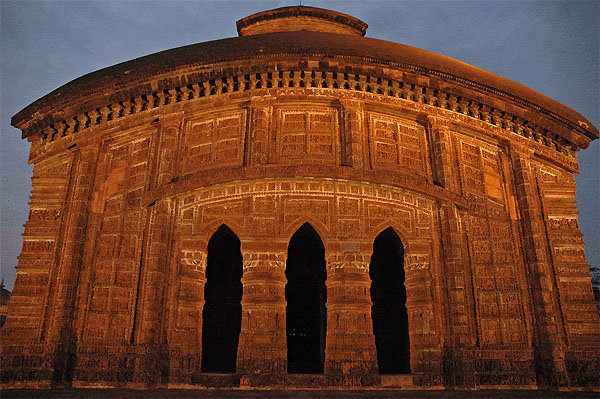
Jor-bangala Temple
Jor-bangla temples are prevalent throughout Bengal. These are comprised of two roofs of huts adjoining one other. Simple yet elegant, there are made of mud baked brick, adorned with sculpted images on the mud walls and on the mud bricks, both inside and out. The Madan Mohan temple at Bistupur and the Shree Dhar temple at Sonamukhi in Bankura district are two good examples of this style. Images from the story of Krishna are seen on the pillars and walls of the jor-bangla temple at Bistupur.
The Jor-bangala temple structure is described thus by the Archeological Survey of India: "Also known as Kesta Rai Temple, it erected by the Malla King, Raghunatha Singha, in AD 1655 as evidenced from the inscription affixed on the front fašade of the temple. The temple, facing south, is raised on a square platform in the form of a pair of hut-shaped structures with sloping roofs joined together and surmounted by a charchala sikhara on the top. Both the exterior and interior walls and ceiling of the temple depict exquisite and elaborate terracotta ornamentation. These terracotta panels narrate scenes from the epics, Krishna lila, hunting scenes, various other depictions of contemporary social life, etc. The excellent quality of art on this temple endows it as one of the finest among the terracotta temples of Bengal."
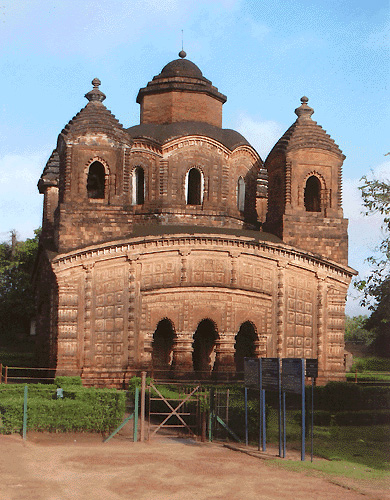
Panchcura Mandira, a panchayatana (five tower) temple
The Krishnaraya temple, built at Bishnupur (or Vishnupur) in 1726 A.D., and the Chaitanya temple at Mayapur in the Hooghly district are also typical examples of jor-bangala architecture. According to Kamat.com, "The Madan Mohan temple is in brick and was erected in 1694. The Shyam Rai (1643 A.D.) and the Madan Gopal (1665 A.D.), built in brick and laterite respectively, have five towers each and are of the panchayatana type. The external decoration of these temples, particularly of those constructed in brick, consists of square panels of terra-cotta reliefs, the subject matter of which is often secular and thus of considerable sociological interest."
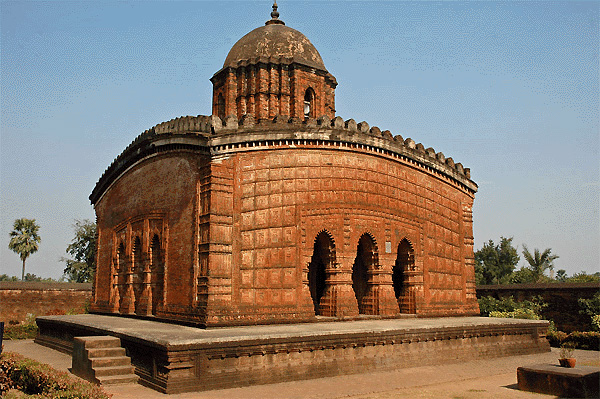
Temple of Madan Mohan
The Madan Mohan temple was built by the Malla King Durjan Singh in AD 1694. The Archeological Survey of India describes it as "the best example in brick of this type of a single sikhara on a curved Bengal chala roof. Its terracotta panels are also noteworthy."
Bishnupur was the capital of the Mallabhum kingdom, once the most important Hindu dynasty in Bengal, founded in the 8th century CE and lasting until the early 19th century. Surrounded by old fortifications, the town of Bishnupur has more than a dozen magnificent terracotta temples. The 16th-century Jor Bangla temple and the 'stepped' Ras Mancha are excellent examples of Bengali style brick temples. They're covered by ornate terracotta tiles that depict scenes from the Vedic epics. The Dhrupad school of music was also founded here during the 16-17th century, under royal patronage.
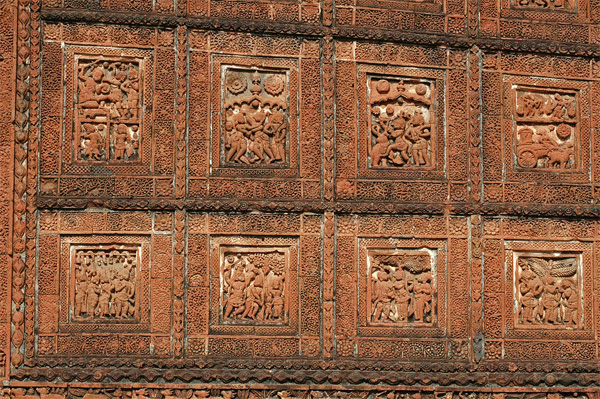
Terracotta Panels from the Madan Mohan Temple
Various other types of temples, some heavily ornamented, are also found in the district of Bankura. Temples near the border of Orissa feature a distinct influence from that state's culture. The Rasa Mancha temple at Bistupur, Siva temple at Ekteshwar, Malleshwar Siva temple at Bistupur, and the heavily ornamented temple at Bahulara remind one of the temples at Bhuvaneswar, and are absolutely of different types.
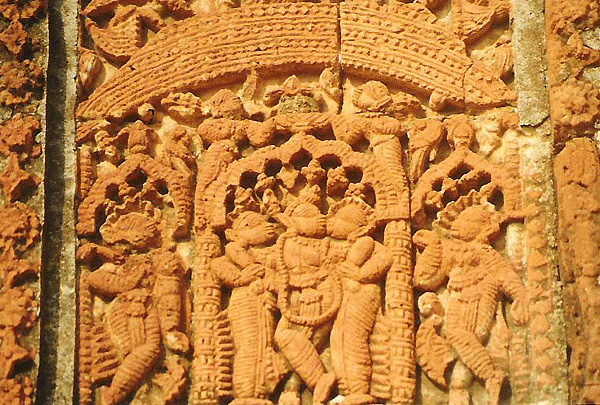
Deatil from a Terracotta Panels on Madan Mohan Temple, depicting Sri Krsna and the gopis.
In part 2 of The Beauty of Bengali Temples, we'll look at the architecture, culture and mood situated around many of West Bengal's most prominent temples, as described by author P.C. Roy Choudhury.
